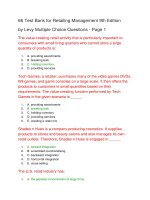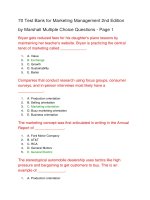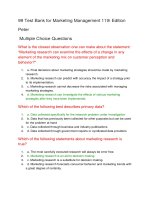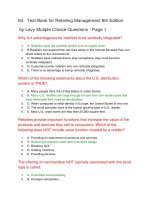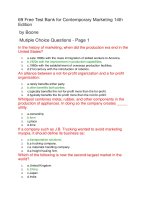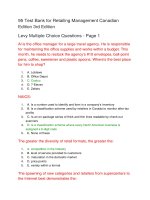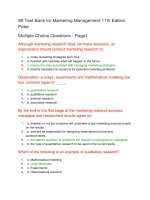110 test bank for contemporary management 8th edition jones
Bạn đang xem bản rút gọn của tài liệu. Xem và tải ngay bản đầy đủ của tài liệu tại đây (158.63 KB, 40 trang )
110 Test Bank for Contemporary Management 8th
Edition Jones
Multiple Choice Questions - Page 1
Which of the following is an example of a company’s standard operating
procedure?
1.
A. A general recommendation that all employees leave their work machines in
good order
2.
B. A compulsory practice of employees cleaning their work areas at the end of
each day
3.
C. An informal code of conduct prescribing that employees help each other if time
permits
4.
D. A suggestion by the technical department to save all work-related files on D
drive
5.
E. A recommendation by the HR department that employees wear formal clothes
during the week
According to Taylor, the production process becomes more efficient
with:
1.
A. an increase in the effort that each worker puts in to produce a unit of output.
2.
B. an increase in the amount of time required to produce a unit of output.
3.
C. an increase in division of labor through specialization.
4.
D. the use of informal-rule-of thumb knowledge.
5.
E. the use of intuitive knowledge.
Administrative management is the study of:
1.
A. how managers control the organization’s relationship with its external
environment.
2.
B. how an organizational structure is to be created such that it leads to high
efficiency and effectiveness.
3.
C. how the feelings, thoughts, and behavior of work group members and
managers affect worker performance.
4.
D. how characteristics of the work setting—specifically the level of lighting—affect
worker performance.
5.
E. how managers should personally behave to motivate employees and
encourage them to perform at high levels.
Which of the following statements is consistent with the principles of
scientific management?
1.
A. Stick to the current method of performing tasks and focus only on increasing
the speed.
2.
B. New methods of performing tasks ought to be communicated verbally rather
than in writing.
3.
C. Allow workers to establish their own rules and SOPs.
4.
D. Establish a standard pay system that is independent of performance.
5.
E. Increase job specialization in order to make the production process more
efficient..
_____ is the process by which division of labor occurs as different
workers gain expertise in tasks over time.
1.
A. Job specialization
2.
B. Systems management
3.
C. Esprit de corps
4.
D. Job rotation
5.
E. Centralization.
Henry Fayol believed that in order to increase the efficiency of the
management process it is essential that:
1.
2.
3.
A. authority should be concentrated at the top of the chain of command.
B. managers should discourage creativity in employees so that they stay focused
on their jobs.
C. there should be greater number of levels in a managerial hierarchy.
4.
D. managers should not have the right give orders to employees; they should only
give polite instructions.
5.
E. all organizational members are entitled to be treated with justice and respect.
_____ refers to a system of task and authority relationships that controls
how employees use resources to achieve a company’s goals.
1.
A. Corporate variance
2.
B. Work sharing
3.
C. Management scalability
4.
D. Organizational structure
5.
E. Job rotation.
Which of the following is true of scientific management?
1.
A. It resulted in jobs that were usually non-repetitive.
2.
B. It brought all workers more gain than hardship.
3.
C. It revealed the maximum efficiency of work systems.
4.
D. It resulted in job dissatisfaction for many workers.
5.
E. It resulted in increased trust between managers and workers.
_____ refers to the chain of command extending from the top to the
bottom of an organization
1.
A. Line of authority
2.
B. Division of labor
3.
C. Unity of direction
4.
D. Unity of command
5.
E. Esprit de corps
An engineer receives orders from and reports to both his department
manager as well as project manager. This violates Fayol’s principle
of:
1.
A. centralization.
2.
B. unity of command.
3.
C. unity of direction.
4.
D. division of labor.
5.
E. esprit de corps.
The line of authority in an organization is:
1.
2.
3.
A. the concentration of authority at the top of the managerial hierarchy.
B. the singleness of purpose that makes possible the creation of one plan of
action.
C. the chain of command extending from the top to the bottom of an organization.
4.
D. the shared feelings of comradeship, enthusiasm, and devotion to a common
cause.
5.
E. a reporting relationship in which an employee receives orders from only one
superior.
_____ refers to a system where small workshops run by skilled workers
produce hand-manufactured products.
1.
A. Mass production
2.
B. Flow production
3.
C. Crafts production
4.
D. Series production
5.
E. Mechanized production
_____ gives managers the right to direct and control their subordinates’
behavior to accomplish organizational goals.
1.
A. Entropy
2.
B. Synergy
3.
C. Esprit de corps
4.
D. Authority
5.
E. Equity
Which of the following principles of management by Henri Fayol specifies
that an employee should report to only one superior?
1.
A. Line of authority
2.
B. Unity of command
3.
C. Centralization
4.
D. Esprit de corps
5.
E. Decentralization
Job specialization refers to:
1.
A. the process by which each position’s formal authority in an organizational
hierarchy is established.
2.
B. the process by which division of labor occurs as different workers gain expertise
in tasks.
3.
C. the process by which subordinates receive orders and report to only one
superior.
4.
D. the process by which members of different departments work together in crossdepartmental teams to accomplish projects.
5.
E. the process by which employees explore new ways to improve how tasks are
performed.
In the context of management, rules refer to:
1.
A. a reporting relationship in which an employee receives orders from only one
superior.
2.
B. the ability of an individual to act on his own accord without direction from a
superior.
3.
C. formal written instructions that specify actions to be taken under different
circumstances.
4.
D. the performance gains that result when individuals and departments coordinate
their actions.
5.
E. the methodical arrangement of positions to provide the organization with the
greatest benefit.
The power to hold workers accountable for their actions and to make
decisions about the use of organizational resources is known
as:
1.
A. initiative.
2.
B. synergy.
3.
C. authority.
4.
D. esprit de corps.
5.
E. entropy.
Which of the following is an example of a rule?
1.
A. A general mandatory guideline asking all employees to leave their work
machines in good order
2.
B. A statement issued by the company specifying the sales projection for the next
fiscal year
3.
C. An informal code of conduct recommending that employees help each other if
time permits
4.
D. A recommendation by the HR department that employees wear formal clothes
during the week
5.
E. A suggestion by the technical department to save all work-related files on D
drive
Which of the following is true of norms?
1.
A. They are mandatory instructions that must be followed by all employees of a
company.
2.
B. They are written instructions about desired behavior in the workplace.
3.
C. They are informal codes of conduct among employees in a particular company.
4.
D. They give detailed instructions about how to perform a certain aspect of a task.
5.
E. They specify actions to be taken under different circumstances to achieve
specific company goals.
_____ refers to a formal system of organization and administration
designed to ensure efficiency and effectiveness.
1.
A. Esprit de corps
2.
B. Bureaucracy
3.
C. Adhocracy
4.
D. Synergy
5.
E. Entropy
Which of the following is true of dual command?
1.
A. It causes confusion among subordinates.
2.
B. It strengthens order and discipline.
3.
C. It makes assessing a manager’s authority easy.
4.
D. It was advocated by Henry Fayol.
5.
E. It exists when a subordinate receives orders from only one supervisor
When the tasks and authority associated with various positions in the
organization are clearly specified, it creates a scenario where:
1.
A. employees are not sure of what is expected either of them or of each other.
2.
B. employees are held strictly accountable for their actions.
3.
C. managers face difficulty in tracking the assigned tasks.
4.
D. confused employees create havoc within the formal hierarchy of authority.
5.
E. order and discipline is undermined.
In a bureaucracy, a manager’s formal authority derives from:
1.
A. his or her social standing and personal contacts.
2.
B. informal rule-of-thumb knowledge.
3.
C. intuitive knowledge.
4.
D. codifying the new methods of performing tasks into written rules.
5.
E. the position he or she holds in the organization.
An advantage of achieving the right worker–task specialization and linking
people and tasks by the speed of the production line is:
1.
A. lower costs.
2.
B. lower job satisfaction.
3.
C. decreased workplace monotony.
4.
D. decreased organizational output.
5.
E. decreased mechanization of work process.
Which of the following is an example of a norm rather than a
rule?
1.
A. A general mandatory guideline asking all employees to leave their work
machines in good order
2.
B. A specific mandatory guideline asking employees to oil machine parts labeled A
and B; and replace C and D
3.
C. An informal code of conduct recommending that employees help each other if
time permits
4.
D. A recommendation by the HR department that employees wear formal clothes
during the week
5.
E. A suggestion by the technical department that all work-related files are saved in
a common location
_____ refers to the concentration of authority at the top of the
organizational chart instead of being distributed throughout the
managerial hierarchy.
1.
A. Unity of direction
2.
B. Synergy
3.
C. Centralization
4.
D. Unity of command
5.
E. Entropy
Which of the following is true of centralization in an
organization?
1.
A. Authority is concentrated at the top of the managerial hierarchy.
2.
B. Subordinates play an important role in decision-making within the company.
3.
C. It prevents the organization from pursuing its strategy.
4.
D. It makes middle and first-line managers more flexible and adaptable.
5.
E. It allows people who are closest to problems to respond to them in a timely
manner.
An organization that has a single, comprehensive long-term plan that
leads every department within the organization is following Fayol’s
principle of:
1.
A. order.
2.
B. line of authority.
3.
C. unity of command.
4.
D. unity of direction.
5.
E. decentralization.
Which of the following is true of rules?
1.
A. They are mandatory instructions.
2.
B. They are unwritten expectations of behavior.
3.
C. They are informal codes of conduct.
4.
D. They focus more on creating goals rather than achieving them.
5.
E. They are suggestions about best practices.
61 Free Free Test Bank for Contemporary
Management 8th Edition Jones Multiple Choice
Questions - Page 2
Which of the following revelations from different research studies came to
be known as the Hawthorne effect?
1.
2.
A. Group members subjecting those workers who violate the group norms to
sanctions
B. Productivity increasing, regardless of the level of illumination in the workplace
3.
C. Workers concealing the true potential efficiency of a work system to protect
their interests
4.
D. Workers’ productivity being affected more by the attention received from
researchers than by the work setting
5.
E. Employees in a “no-talking” workplace developing ways of talking to one
another out of the sides of their mouths.
According to Henri Fayol, esprit de corps refers to:
1.
A. the ability to act on one’s own without direction from a superior.
2.
B. shared feelings of comradeship, enthusiasm, or devotion to a common cause
among members of a group.
3.
C. the justice, impartiality, and fairness to which all organizational members are
entitled.
4.
D. the methodical arrangement of positions to provide the organization with the
greatest benefit and to provide employees with career opportunities.
5.
E. obedience, energy, application, and other outward marks of respect for a
superior’s authority.
In the context of human relations movement and related studies, who
among the following is a “ratebuster?”
1.
A. A person performing above the work group performance norm
2.
B. A person performing below the work group performance norm
3.
C. A person performing at the pace the manager requests
4.
D. A person performing below the company performance standard
5.
E. A person performing at a pace he feels matches his pay
_____ is the idea that the organizational structures and control systems
that are chosen by managers depend on characteristics of the external
environment in which the organization operates.
1.
A. Equity theory
2.
B. Contingency theory
3.
C. Theory X
4.
D. Theory Y
5.
E. Behavioral management theory
The management theory that focuses on the use of rigorous quantitative
techniques to assist managers to make the best use of organizational
resources is called:
1.
A. contingency theory.
2.
B. management science theory.
3.
C. administrative management theory.
4.
D. behavioral management theory.
5.
E. human relations theory.
Which of the following practices was advocated by Mary Parker
Follett?
1.
A. Workers should not be allowed to participate in the work development process.
2.
B. Authority should go with hierarchical positions rather than knowledge.
3.
C. Managers should behave as monitors and supervisors.
4.
D. Workers should be allowed to exercise initiative in their everyday work lives.
5.
E. Members of each department should stick to their own department; crossfunctioning should be discouraged.
A company that wishes to increase the quality of its products should opt
for _____, a branch of management science that provides tools to analyze
the company’s input, conversion, and output activities.
1.
A. Quantitative management
2.
B. Operations management
3.
C. Total quality management
4.
D. Management information systems
5.
E. Numerical management
Mary Parker Follett’s primary criticism of Taylor’s system of scientific
management was that:
1.
A. Taylor proposed that managers should involve workers in analyzing their jobs to
identify better ways to perform tasks.
2.
B. Taylor did not use scientific techniques like time-and-motion studies to analyze
workers’ jobs.
3.
C. scientific management did not allow workers to exercise initiative and contribute
to the organization.
4.
D. scientific management advocated that workers, rather than managers, should
be in control of the work process itself.
5.
E. Taylor said that managers should behave as coaches and facilitators—not as
monitors and supervisors.
According to Henri Fayol, discipline refers to:
1.
A. the ability to act on one’s own without direction from a superior.
2.
B. shared feelings of comradeship, enthusiasm, or devotion to a common cause
among members of a group.
3.
C. the justice, impartiality, and fairness to which all organizational members are
entitled.
4.
D. the methodical arrangement of positions to provide the organization with the
greatest benefit and to provide employees with career opportunities.
5.
E. Stability of tenure of personnel
Mayfair Mobile’s external environment is changing rapidly and it responds
by decentralizing decisions to lower-level managers so that the
organization can react faster. Which of the following types of
organizational structure allows this?
1.
A. A mechanistic structure
2.
B. A formal structure
3.
C. A bureaucratic structure
4.
D. An oligarchic structure
5.
E. An organic structure
Which of the following statements indicates that Megabytes Inc. has
implemented an organic structure?
1.
2.
A. At Megabytes, employees are discouraged from taking up more responsibilities.
B. At Megabytes, forming of cross-departmental or functional teams is
discouraged.
3.
C. At Megabytes, employees are closely supervised and follow well-defined rules.
4.
D. At Megabytes, emphasis is placed on strict discipline and order.
5.
E. At Megabytes, authority is decentralized to middle and first-line managers.
EZtronics’ approach to management is consistent with Theory Y
because:
1.
2.
A. managers at EZtronics control workers’ behavior by means of rewards and
punishments.
B. managers at EZtronics closely supervise their subordinates.
3.
C. managers at EZtronics do not believe in giving workers any autonomy in
solving problems.
4.
D. managers at EZtronics have created a work setting that allows workers to
exercise initiative.
5.
E. managers at EZtronics have created a work setting that reflects a belief that
workers are lazy.
The Marketing Manager at RST Global Inc. developed a five-year
marketing plan that was in stark contrast with the objectives outlined in
the organization’s strategic plan. Which of the principles of Henri Fayol
does this go against?
1.
A. Order
2.
B. Line of authority
3.
C. Unity of command
4.
D. Unity of direction
5.
E. Span of control
Which of the following best reflects Mary Parker Follett’s views on
management and leadership in an organization?
1.
A. Managers should avoid involving workers in analyzing their jobs to identify
better ways to perform tasks as this could lead to employees underperforming.
2.
B. If workers have the relevant knowledge, then workers, rather than managers,
should be in control of the work process itself.
3.
C. The formal line of authority and vertical chain of command are the most
essential steps to effective management.
4.
D. Members of different departments should avoid working together in crossdepartmental teams to accomplish projects in order to minimize duplication of effort.
5.
E. Managers’ formal authority deriving from their position in the hierarchy should
decide who will lead at any particular moment.
The aspect of management theory that uses mathematical techniques
such as modeling and simulation to help managers make better decisions
is called:
1.
A. behavioral management.
2.
B. contingency management.
3.
C. quantitative management.
4.
D. administrative management.
5.
E. human relations management.
According to Henri Fayol, initiative refers to:
1.
A. the ability to act on one’s own without direction from a superior.
2.
B. shared feelings of comradeship, enthusiasm, or devotion to a common cause
among members of a group.
3.
C. the justice, impartiality, and fairness to which all organizational members are
entitled.
4.
D. the methodical arrangement of positions to provide the organization with the
greatest benefit and to provide employees with career opportunities.
5.
E. obedience, energy, application, and other outward marks of respect for a
superior’s authority.
_____ refers to the tendency of a closed system to lose its ability to
control itself, and thus disintegrate.
1.
A. Synergy
2.
B. Entropy
3.
C. Esprit de corps
4.
D. Order
5.
E. Equity
If an organization has a profit-sharing plan in which employees are able to
purchase the company’s stock at a discount whenever the organization
makes huge profits, then this organization follows Fayol’s principle
of:
1.
A. centralization.
2.
B. discipline.
3.
C. initiative.
4.
D. esprit de corps.
5.
E. remuneration of personnel.
The idea that workers should be aware of how their performance affects
the performance of the organization as a whole is most consistent with
Fayol’s principle of:
1.
A. unity of command.
2.
B. subordination of individual interests to the common interest.
3.
C. remuneration of personnel.
4.
D. esprit de corps.
5.
E. stability of tenure of personnel.
If a manager designs the organizational hierarchy based on the
characteristics of the organizational environment, he is acting in
accordance with _____.
1.
A. Equity theory
2.
B. Fayol’s theory
3.
C. Contingency theory
4.
D. Queuing theory
5.
E. Chaos theory
Which of the following is true of an open system?
1.
A. It is more likely to experience entropy than is a closed system.
2.
B. It uses resources from the external environment for internal processes, but
does not return anything to the external environment.
3.
C. The input, process, and output stages in the production process are performed
in the external environment.
4.
D. It is a self-contained system that is not affected by changes in its environment.
5.
E. It takes in resources from its external environment and converts them into
goods that are then sent back to that environment for purchase by customers.
Managers who accept the assumptions of Theory Y:
1.
A. create a work setting that encourages commitment.
2.
B. give little autonomy to workers.
3.
C. focus on developing rules and procedures.
4.
D. rely on rewards and punishments.
5.
E. view workers as lazy.
Managers who accept the assumptions of Theory X:
1.
A. create a work setting that encourages commitment to organization goals.
2.
B. closely monitor workers to make sure that production is not affected.
3.
C. focus on giving employees opportunities to exercise initiative.
4.
D. provide opportunities for workers to be imaginative.
5.
E. view workers as motivated and capable of exercising self-control.
The human relations movement advocates that:
1.
A. mangers use punishments as a tool to elicit cooperation from employees.
2.
B. the level of work group performance be controlled by workers.
3.
C. employees be monitored outside the workplace.
4.
D. supervisors be behaviorally trained to manage subordinates.
5.
E. supervisors make all the important decisions concerning the company.
Fayol’s principle of initiative suggests that:
1.
A. employees ought to be closely monitored.
2.
B. managers should encourage employees to be innovative and creative.
3.
4.
5.
C. managers should ensure that the tasks and roles of each employee are clearly
specified.
D. authority should be concentrated at the top of the hierarchy.
E. mangers should use rewards and punishments to control the behavior of
employees.
The primary message of _____ is that there is no one best way to
organize.
1.
A. Theory X
2.
B. administrative management theory
3.
C. contingency theory
4.
D. behavioral management theory
5.
E. management science theory
Fayol recommended the use of _____ to show the position and duties of
each employee and to indicate which positions an employee might move
to or be promoted to in the future.
1.
A. an organizational chart
2.
B. initiative analysis
3.
C. unity of direction
4.
D. critical path method (CPM)
5.
E. PERT chart
_____ is the study of the factors that have an impact on how individuals
and groups respond to and act in organizations.
1.
A. Hawthorne studies
2.
B. Organizational behavior
3.
C. Management science
4.
D. Scientific management
5.
E. Administrative management.
Obedience to a manager’s authority is most consistent with Fayol’s
principle of:
1.
A. order.
2.
B. discipline.
3.
C. esprit de corps.
4.
D. equity.
5.
E. decentralization
Which of the following is true of an organization with a mechanistic
structure?
1.
A. The organization uses the structure only when needed—when the
organizational environment is unstable.
2.
B. A mechanistic structure requires more managerial time, money, and effort than
an organic structure.
3.
C. Employees are closely supervised and follow well-defined rules and standard
operating procedures.
4.
D. Authority is decentralized to middle and first-line managers to encourage them
to take responsibility.
5.
E. Here, managers can react more quickly to a changing environment than can
managers in an organic structure.
The idea that employees who stay with the organization for many years
develop skills on the job which can help the organization to become more
efficient is consistent with Fayol’s principle of:
1.
A. unity of command.
2.
B. unity of direction.
3.
C. initiative.
4.
D. discipline.
5.
E. stability of tenure.
_____ is the performance gain caused by two or more departments
coordinating their efforts.
1.
A. Synergy
2.
B. Entropy
3.
C. Esprit de corps
4.
D. Order
5.
E. Equity
True - False Questions
In his studies, Adam Smith found that the performance of the factories in
which workers specialized in only one or a few tasks was much greater
than the performance of the factory in which each worker performed all
the tasks.
1.
True
2.
False
Henri Fayol’s approach to administration more closely reflects the
assumptions of McGregor’s Theory X as compared to Theory Y.
1.
True
2.
False
F.W. Taylor advocated the use of a standard pay system that was
independent of worker performance.
1.
True
2.
False
When authority is centralized, only managers at the top of the
organization make important decisions.
1.
True
2.
False
According to Weber, in a bureaucracy, people should occupy positions
because of their social standing and personal contacts.
1.
True
2.
False
Rules are formal written instructions that specify what workers should do
on the job.
1.
True
2.
False
When managers rely too much on rules to solve problems, their behavior
becomes inflexible.
1.
True
2.
False
